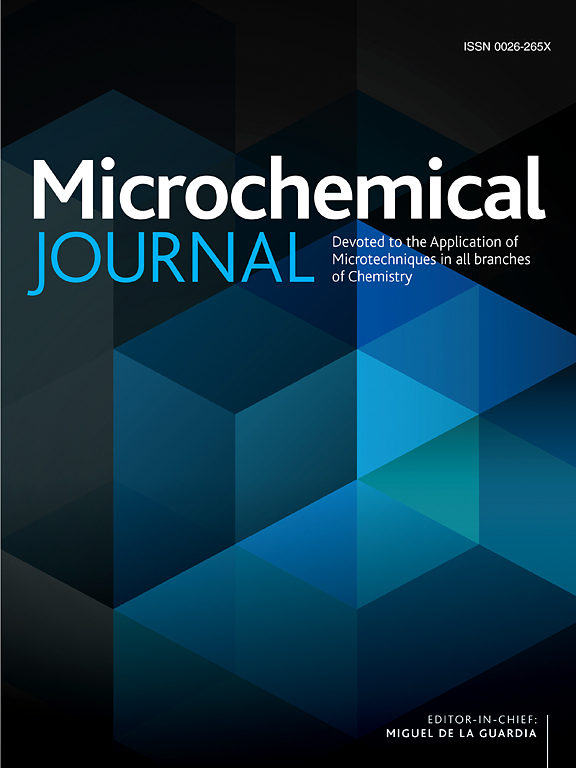Potential of high-throughput FIA-MS/MS and LC-MS/MS polyphenolic profiling to assess tea authenticity. Application to tea adulterations with chicory
IF 4.9
2区 化学
Q1 CHEMISTRY, ANALYTICAL
引用次数: 0
Abstract
Tea can be found among the beverages more susceptible to fraudulent practices because of its high worldwide consumption and the increases on prices for some specific varieties due to climate change and geopolitical instability. Tea adulteration with other plants, such as chicory, is a common practice to gain an illicit profit. Polyphenols are abundant bioactive substances in tea, determining its quality and health function. In addition, they can be employed as markers to address authentication issues. The present contribution assesses the potential of polyphenolic profiling by high-throughput FIA-MS/MS and LC-MS/MS methodologies for tea authenticity. One hundred tea samples belonging to different varieties (green, black, red, oolong, and white teas) and 20 chicory samples were analyzed with both methodologies after a simple brewing process to profile fifty-five polyphenols belonging to different families. The resulting chemical descriptors were used to address tea classification and authentication by partial least-squares-discriminant analysis (PLS-DA). An excellent classification performance by PLS-DA was accomplished, with sensitivity and specificity values for FIA-MS/MS higher than 90% and 88.9%, respectively, and for LC-MS/MS higher than 85% and 86%, respectively. Good accuracy was also attained, with calibration errors below 10.5 and 14.5% for FIA-MS/MS and LC-MS/MS, respectively. Overall, FIA-MS/MS showed a better performance than LC-MS/MS, with the additional advantage of shorter analysis time as no chromatographic separation was required. The capability of phenolics to quantify tea adulterations with chicory was also assessed by partial least squares (PLS) regression, with prediction errors below 10.9 and 14.8% for FIA-MS/MS and LC-MS/MS, respectively, in the determination of adulterant levels. Thus, both methodologies demonstrated to be feasible for assessing tea authentication issues.

高通量 FIA-MS/MS 和 LC-MS/MS 多酚分析评估茶叶真伪的潜力。在掺入菊苣的茶叶中的应用
茶叶是最容易受到欺诈行为影响的饮料之一,因为它在全世界的消费量很高,而且由于气候变化和地缘政治不稳定,一些特定品种的茶叶价格上涨。在茶叶中掺杂菊苣等其他植物是获取非法利润的常见做法。茶多酚是茶叶中丰富的生物活性物质,决定着茶叶的品质和保健功能。此外,茶多酚还可用作解决鉴定问题的标记。本文通过高通量 FIA-MS/MS 和 LC-MS/MS 方法评估了茶叶真伪的多酚分析潜力。在经过简单的冲泡过程后,采用这两种方法分析了 100 个不同品种的茶叶样品(绿茶、红茶、红茶、乌龙茶和白茶)和 20 个菊苣样品,以确定属于不同系列的 55 种茶多酚。得出的化学描述符被用于通过偏最小二乘判别分析(PLS-DA)对茶叶进行分类和鉴定。PLS-DA 的分类效果极佳,FIA-MS/MS 的灵敏度和特异度分别高于 90% 和 88.9%,LC-MS/MS 的灵敏度和特异度分别高于 85% 和 86%。FIA-MS/MS 和 LC-MS/MS 的校准误差分别低于 10.5%和 14.5%,准确度也很高。总体而言,FIA-MS/MS 的性能优于 LC-MS/MS,而且由于无需色谱分离,分析时间更短。通过偏最小二乘法(PLS)回归评估了酚类物质定量掺杂菊苣的茶叶的能力,在确定掺杂物水平时,FIA-MS/MS 和 LC-MS/MS 的预测误差分别低于 10.9% 和 14.8%。因此,这两种方法在评估茶叶鉴别问题上都是可行的。
本文章由计算机程序翻译,如有差异,请以英文原文为准。
求助全文
约1分钟内获得全文
求助全文
来源期刊

Microchemical Journal
化学-分析化学
CiteScore
8.70
自引率
8.30%
发文量
1131
审稿时长
1.9 months
期刊介绍:
The Microchemical Journal is a peer reviewed journal devoted to all aspects and phases of analytical chemistry and chemical analysis. The Microchemical Journal publishes articles which are at the forefront of modern analytical chemistry and cover innovations in the techniques to the finest possible limits. This includes fundamental aspects, instrumentation, new developments, innovative and novel methods and applications including environmental and clinical field.
Traditional classical analytical methods such as spectrophotometry and titrimetry as well as established instrumentation methods such as flame and graphite furnace atomic absorption spectrometry, gas chromatography, and modified glassy or carbon electrode electrochemical methods will be considered, provided they show significant improvements and novelty compared to the established methods.
 求助内容:
求助内容: 应助结果提醒方式:
应助结果提醒方式:


